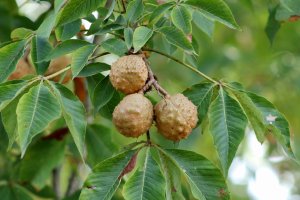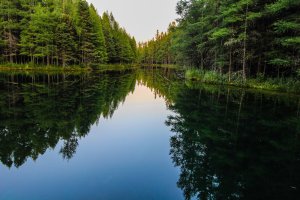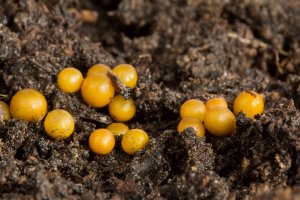Worms, Warmth, and Wind: How Invasive Species and Changing Climates are Shaping the North
May 24, 2023
by Ali Groulx, Park Interpreter
The winter of 2023 brought us mild temperatures mixed with several severe snow and ice storms that closed schools and hindered life for many Southeast Michiganders. If you have noticed an influx of extreme weather patterns, you are not alone. The plants and animals have noticed, too. What happens when our shared home no longer looks or feels like the Michigan we have known? Our values and our heritage are impacted by the changing climate and weather patterns. These changes can pave the way for invasive plants, insects, and animal species to take up residence. Our way of life, our sense of place, culture, values, and traditions of interacting with our environment are all affected by climate change. Please do not be alarmed; with the strong togetherness we possess as Southeastern Michiganders, we can implement good habits and create positive change for the generations to come.
With the extreme weather shifts, species that thrive in warmer climates creep further north every year. This includes fungi, bacteria, non-native viruses, and other pathogens that can harm humans and wildlife. Invasive plants favor these shifting conditions. Devastating woody vines like Asiatic bittersweet can end a tree’s life by weighing it down and blocking valuable sunlight. Deer-resistant shrubs like autumn olive and glossy buckthorn can quickly dominate young forests, as the deer prefer to browse native plants. Low-lying forbs like garlic mustard can inhibit the growth of other plant species with their ability to disturb the soil’s natural chemistry, and their tendency to send their seeds along with the wind. There are some not-so-foreign invaders though, too. Scientists call these species neonative, because although they are native to other parts of our continent, they tend to act like invasives here. Unfortunately, this includes the notorious buckeye tree that is native to Ohio. In the past, buckeye seeds that made it to Michigan were not able to grow due to lack of proper heat and growing conditions. Now that we are experiencing warmer average temperatures, our Wolverine state is in danger of a buckeye invasion.

Did you know that earthworms are an invasive species in Michigan? Ten thousand years ago, Michigan was still covered in one-mile thick sheet of ice. This glaciation was thought to have killed off any earthworms that may have existed here prior to the ice cover as it scraped and scooped and covered the landscape. Earthworms are sometimes called ‘ecosystem engineers.’ They play a huge role in the environments they traditionally belong in, which includes the Pacific Northwest and the Southeast United States, along with their homes on continents across the pond. Here in Michigan, organisms like mites, nematodes, millipedes, and fungi are the ones that help break down the organic matter that covers forest floors. In our native habitats, this historically happens at a very slow rate. This is a feature that makes the indigenous forests of the Great Lakes area so unique. Ecosystems like the boreal forests of the Upper Peninsula have their mineral soil protected by a layer of rotting leaves, mosses, and fallen wood. In warmer climates, the typical forest floor is a mix of mineral soil and organic soil, without that special layer of leaf debris. As earthworms are introduced to these leaf-covered environments, they find homes that are overflowing with their favorite things to eat… until they eat it all. As earthworms devour the leafy and mossy floors of our forests, the pH changes, as well as the texture, density, and the nutrients found in the soil. This can lead to detrimental changes, like creating perfect growing spots for invasive plants such as the aforementioned autumn olive, Asiatic bittersweet, garlic mustard, and glossy buckthorn, as well as pushing out our native ‘ecosystem engineers.’ Earthworms are moving further and further north each year due to the warming climate, which isthreatening ecosystems like the boreal forests in the north. This can grow to be a large problem. Traditionally, boreal forests are known to be an important terrestrial reservoir, or storage container, of carbon. This means that the boreal forests are in danger of emitting more carbon than they absorb. As the leaf litter is quickly broken down by earthworms, carbon is released at a rate that the trees cannot offset.

Earthworms, seeds from invasive plants, and invasive pathogens can be spread by improperly cleaned shoes, dirty tires of off-road vehicles, and camping and fishing gear. Practices like releasing unused bait have contributed to a rise in earthworm populations, too. Worm cocoons are very small and very strong. They tend to look like pieces of dirt and they can travel easily, so it is imperative that we try our best to eliminate the risks by properly disposing of our bait and cleaning our shoes and equipment whenever traveling to other areas.

Invasive species control is a team effort. Early detection and knowing who to tell is very important. You can report invasives with programs like MISIN, an organization created by the DNR and MSU. You can do this by downloading the app or going to their website, where you can report suspected invasive species with GPS location and more about them. If you notice invasives in your yard or neighborhood, feel free to document them. Invasive species control can be integrated into your regular yard-work routine. It is our responsibility as current residents and stewards of this land to work together to stop the spread of invasives where we can. Action, as well as inaction, can have a substantial and lasting impact. We must slow down and take stock of our belongings and our environment to protect our Southeast Michigan home for generations to come. You never know who, or what, is joining you on your journey. Taking a few spare moments to observe the plants and animals surrounding your home, workplace, and school is a wonderful start. Together, we can slow the spread of invasive species to maintain the integrity of our unique Michigan habitats.
